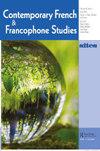孤独,假肢纪念碑
IF 0.2
4区 文学
0 LITERATURE, ROMANCE
引用次数: 0
摘要
摘要2007年5月10日,巴格纽克斯市为纪念废除奴隶制和为人类解放而战的雕塑揭幕。这座三方纪念碑由艺术家尼古拉斯·阿尔金雕刻,旨在纪念瓜德罗普岛抵抗运动的传奇人物“孤独”。如果市政当局对应该举办雕塑的地方犹豫不决,它最终选择将其竖立在靠近皮埃尔·普拉特社区的地方。该地点对市政厅来说具有战略意义,市政厅希望挫败黑人、阿拉伯和犹太社区之间的社会政治和多民族紧张关系。正是这座低成本住宅群在2006年登上了国内外新闻的头版。人们还记得绑架并折磨23岁犹太人伊兰·哈利米的“野蛮团伙”。这起反犹太主义仇恨犯罪震惊了法国社会,他们要求进行政治动员。有了这个纪念碑和这个位置,我认为会产生一种不特定的效果。通过借来的记忆和假肢联想,伊兰的记忆与孤独的记忆结合在一起,两者都是统一的,都被定义为拉伊奇烈士。经过更新,雕塑超越了时间平衡,成为当代不同种族社区的替代媒介,这些社区也是暴力的受害者。本文章由计算机程序翻译,如有差异,请以英文原文为准。
Solitude, monument prothétique
Abstract May 10, 2007, the city of Bagneux inaugurates a sculpture commemorating the abolition of slavery and the fights for human emancipation. Sculpted by the artist Nicolas Alquin, this tripartite monument, celebrates Solitude, legendary figure of the resistance in Guadeloupe. If the municipality hesitates on the place which should host the sculpture, it finally chooses to erect it close to the Pierre Plate neighborhood. The location is strategic for the town hall, which wants to thwart socio-political and multi-ethnic tensions between Black, Arab and Jewish communities. It is indeed this low-cost housing complex which made the front page of the national and international news in 2006. One remembers the “gang des barbares” who kidnapped and tortured Ilan Halimi, a twenty-three year old Jew. This antisemitic hate crime shocked French society who pressed for political mobilization. With this monument and this location, I argue that a despecification effect occurs. Through borrowed memories and prosthetic associations, the memory of Ilan joins that of Solitude, both united and defined as laïc martyrs. Renewed, the sculpture became, by transgression of the temporal equilibrium, a substitute medium for different contemporary ethnic communities who are also victims of violence.
求助全文
通过发布文献求助,成功后即可免费获取论文全文。
去求助
来源期刊

Contemporary French and Francophone Studies
LITERATURE, ROMANCE-
CiteScore
0.30
自引率
0.00%
发文量
43
期刊介绍:
An established journal of reference inviting all critical approaches on the latest debates and issues in the field, Contemporary French & Francophone Studies (formerly known as SITES) provides a forum not only for academics, but for novelists, poets, artists, journalists, and filmmakers as well. In addition to its focus on French and Francophone studies, one of the journal"s primary objectives is to reflect the interdisciplinary direction taken by the field and by the humanities and the arts in general. CF&FS is published five times per year, with four issues devoted to particular themes, and a fifth issue, “The Open Issue” welcoming non-thematic contributions.
 求助内容:
求助内容: 应助结果提醒方式:
应助结果提醒方式:


